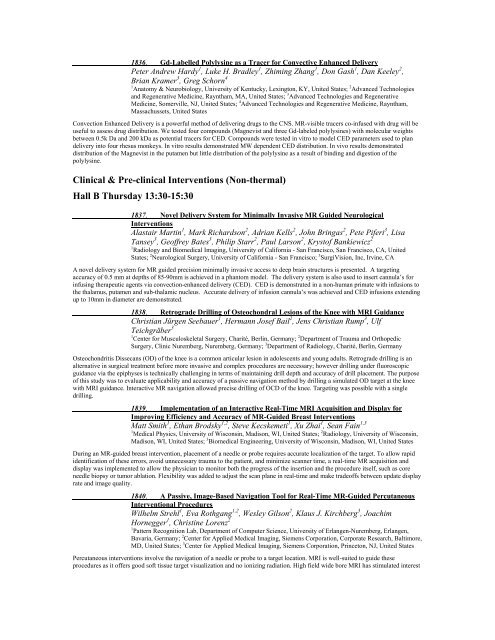Traditional Posters: Interventional - ismrm
Traditional Posters: Interventional - ismrm
Traditional Posters: Interventional - ismrm
You also want an ePaper? Increase the reach of your titles
YUMPU automatically turns print PDFs into web optimized ePapers that Google loves.
1836. Gd-Labelled Polylysine as a Tracer for Convective Enhanced Delivery<br />
Peter Andrew Hardy 1 , Luke H. Bradley 1 , Zhiming Zhang 1 , Don Gash 1 , Dan Keeley 2 ,<br />
Brian Kramer 3 , Greg Schorn 4<br />
1 Anatomy & Neurobiology, University of Kentucky, Lexington, KY, United States; 2 Advanced Technologies<br />
and Regenerative Medicine, Rayntham, MA, United States; 3 Advanced Technologies and Regenerative<br />
Medicine, Somerville, NJ, United States; 4 Advanced Technologies and Regenerative Medicine, Rayntham,<br />
Massachussets, United States<br />
Convection Enhanced Delivery is a powerful method of delivering drugs to the CNS. MR-visible tracers co-infused with drug will be<br />
useful to assess drug distribution. We tested four compounds (Magnevist and three Gd-labeled polylysines) with molecular weights<br />
between 0.5k Da and 200 kDa as potential tracers for CED. Compounds were tested in vitro to model CED parameters used to plan<br />
delivery into four rhesus monkeys. In vitro results demonstrated MW dependent CED distribution. In vivo results demonstrated<br />
distribution of the Magnevist in the putamen but little distribution of the polylysine as a result of binding and digestion of the<br />
polylysine.<br />
Clinical & Pre-clinical Interventions (Non-thermal)<br />
Hall B Thursday 13:30-15:30<br />
1837. Novel Delivery System for Minimally Invasive MR Guided Neurological<br />
Interventions<br />
Alastair Martin 1 , Mark Richardson 2 , Adrian Kells 2 , John Bringas 2 , Pete Piferi 3 , Lisa<br />
Tansey 3 , Geoffrey Bates 3 , Philip Starr 2 , Paul Larson 2 , Krystof Bankiewicz 2<br />
1 Radiology and Biomedical Imaging, University of California - San Francisco, San Francisco, CA, United<br />
States; 2 Neurological Surgery, University of California - San Francisco; 3 SurgiVision, Inc, Irvine, CA<br />
A novel delivery system for MR guided precision minimally invasive access to deep brain structures is presented. A targeting<br />
accuracy of 0.5 mm at depths of 85-90mm is achieved in a phantom model. The delivery system is also used to insert cannula’s for<br />
infusing therapeutic agents via convection-enhanced delivery (CED). CED is demonstrated in a non-human primate with infusions to<br />
the thalamus, putamen and sub-thalamic nucleus. Accurate delivery of infusion cannula’s was achieved and CED infusions extending<br />
up to 10mm in diameter are demonstrated.<br />
1838. Retrograde Drilling of Osteochondral Lesions of the Knee with MRI Guidance<br />
Christian Jürgen Seebauer 1 , Hermann Josef Bail 2 , Jens Christian Rump 3 , Ulf<br />
Teichgräber 3<br />
1 Center for Musculoskeletal Surgery, Charité, Berlin, Germany; 2 Department of Trauma and Orthopedic<br />
Surgery, Clinic Nuremberg, Nuremberg, Germany; 3 Department of Radiology, Charité, Berlin, Germany<br />
Osteochondritis Dissecans (OD) of the knee is a common articular lesion in adolescents and young adults. Retrograde drilling is an<br />
alternative in surgical treatment before more invasive and complex procedures are necessary; however drilling under fluoroscopic<br />
guidance via the epiphyses is technically challenging in terms of maintaining drill depth and accuracy of drill placement. The purpose<br />
of this study was to evaluate applicability and accuracy of a passive navigation method by drilling a simulated OD target at the knee<br />
with MRI guidance. Interactive MR navigation allowed precise drilling of OCD of the knee. Targeting was possible with a single<br />
drilling.<br />
1839. Implementation of an Interactive Real-Time MRI Acquisition and Display for<br />
Improving Efficiency and Accuracy of MR-Guided Breast Interventions<br />
Matt Smith 1 , Ethan Brodsky 1,2 , Steve Kecskemeti 1 , Xu Zhai 1 , Sean Fain 1,3<br />
1 Medical Physics, University of Wisconsin, Madison, WI, United States; 2 Radiology, University of Wisconsin,<br />
Madison, WI, United States; 3 Biomedical Engineering, University of Wisconsin, Madison, WI, United States<br />
During an MR-guided breast intervention, placement of a needle or probe requires accurate localization of the target. To allow rapid<br />
identification of these errors, avoid unnecessary trauma to the patient, and minimize scanner time, a real-time MR acquisition and<br />
display was implemented to allow the physician to monitor both the progress of the insertion and the procedure itself, such as core<br />
needle biopsy or tumor ablation. Flexibility was added to adjust the scan plane in real-time and make tradeoffs between update display<br />
rate and image quality.<br />
1840. A Passive, Image-Based Navigation Tool for Real-Time MR-Guided Percutaneous<br />
<strong>Interventional</strong> Procedures<br />
Wilhelm Strehl 1 , Eva Rothgang 1,2 , Wesley Gilson 2 , Klaus J. Kirchberg 3 , Joachim<br />
Hornegger 1 , Christine Lorenz 2<br />
1 Pattern Recognition Lab, Department of Computer Science, University of Erlangen-Nuremberg, Erlangen,<br />
Bavaria, Germany; 2 Center for Applied Medical Imaging, Siemens Corporation, Corporate Research, Baltimore,<br />
MD, United States; 3 Center for Applied Medical Imaging, Siemens Corporation, Princeton, NJ, United States<br />
Percutaneous interventions involve the navigation of a needle or probe to a target location. MRI is well-suited to guide these<br />
procedures as it offers good soft tissue target visualization and no ionizing radiation. High field wide bore MRI has stimulated interest















